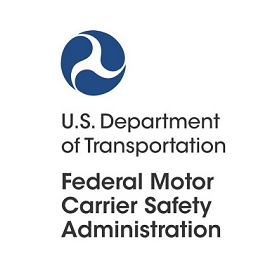
With inter-state commerce being so vital to our economy, these agencies have developed regulations that must be adhered to throughout the country and provide uniformity, accountability and protect the flow of commerce and people throughout the country.
Federal Motor Carrier Safety Administration (FMCSA)
As the lead federal government agency responsible for regulating and providing safety oversight of commercial motor vehicles (CMVs), FMCSA’s mission is to reduce crashes, injuries, and fatalities involving large trucks and buses.
FMCSA partners with industry, safety advocates, and state and local governments to keep our nation’s roadways safe and improve CMV safety through regulation, education, enforcement, research, and technology. Some of their safety programs include:
- Compliance, Safety, Accountability
- National Registry of Certified Medical Examiners
- Commercial Driver’s License (CDL) Program
- Motor Carrier Safety Assistance Program
- New Entrant Program
- Hazardous Materials (HM) Program
You can learn more about the FMCSA agency by CLICKING HERE.
You can review the FMCSA Passenger Carrier Regulations HERE.

Through enforcing vehicle performance standards and partnerships with state and local governments, the National Highway Traffic Safety Administration (NHTSA) reduces deaths, injuries and economic losses from motor vehicle crashes.
CLICK HERE to learn more about School Bus Safety topics from the NHTSA.
IMPORTANT FEDERAL REGULATIONS
Authority to Operate
Companies that operate commercial vehicles transporting passengers or hauling cargo in interstate commerce must be registered with the FMCSA and must have a USDOT Number. Apart from federal regulations, some states require their intrastate commercial motor vehicle registrants to obtain a USDOT Number. (Michigan does requires this)
The USDOT Number serves as a unique identifier when collecting and monitoring a company’s safety information acquired during audits, compliance reviews, crash investigations, and inspections.
In general, companies that transport passengers in interstate commerce are required to have interstate Operating Authority (MC number) in addition to a DOT number. FMCSA operating authority is often identified as an “MC,” “FF,” or “MX” number, depending on the type of authority that is granted.
INTERstate vs INTRAstate
Interstate commerce and intrastate commerce refer to two different ways of transporting cargo or people. The term interstate means that the commercial driver moves cargo or people across state lines. Specifically, it includes the following definitions:
- Between a place in a state and a place outside of such state (including a place outside of the United States)
- Between two places in a state through another state or a place outside of the United States
- Between two places in a state as part of trade, traffic, or transportation originating or terminating outside the state or the United States
With intrastate commerce, the driver remains within the boundaries of a single state. This is typically the state where the employer bases operations as well as where the driver has a permanent residence. Both types of operations require operating authority, from the Federal Motor Carrier Safety Administration (FMCSA).
For-Hire vs Private Carriers
Any time a passenger carrier receives compensation for transporting passengers, it is considered for-hire. Unless subject to an exemption, all for-hire passenger carriers in interstate commerce must:
- Obtain FMCSA operating authority registration (no matter how small or light the vehicles used);
- Obtain and file minimum levels of financial responsibility (insurance): $1.5 million for operating vehicles of 15 or fewer passengers including the driver; $5 million for operating vehicles of 16 or more passengers including the driver; and
- Designate a process agent, a representative that can be served with court papers in any legal proceeding brought against a motor carrier.
Understanding Safety Regulations
All passenger carriers — both for-hire and private — generally are under Federal safety jurisdiction if their vehicles are operating in interstate commerce and meet the definition of a commercial motor vehicle (CMV). A vehicle that meets one or more of the following criteria is a CMV:
- Has a gross vehicle weight (GVW) or gross vehicle weight rating (GVWR) of 10,001 pounds or more; or
- Is designed or used to transport 9 or more passengers (including the driver) for compensation; or
- Is designed or used to transport 16 or more passengers, including the driver, regardless of whether it is used to transport passengers for compensation.
Commercial Driver’s License (CDL) Requirements
Additionally, drivers operating a vehicle that meets one or more of the following criteria must have a CDL with the appropriate endorsement(s):
- Has a gross vehicle weight (GVW) or gross vehicle weight rating (GVWR) of 10,001 pounds or more; or
- Is designed or used to transport 9 or more passengers (including the driver) for compensation; or
- Is designed or used to transport 16 or more passengers, including the driver, regardless of whether it is used to transport passengers for compensation.


